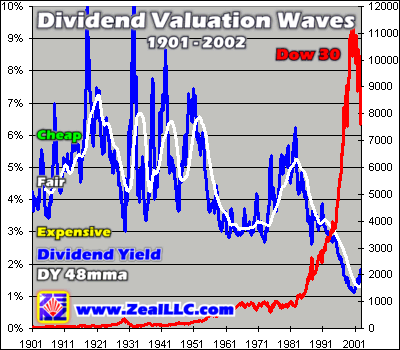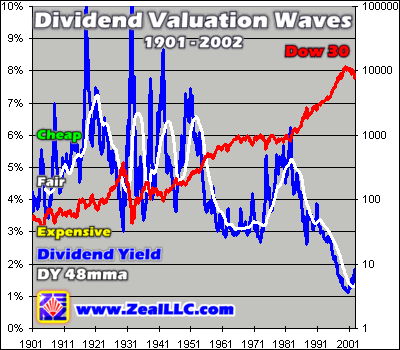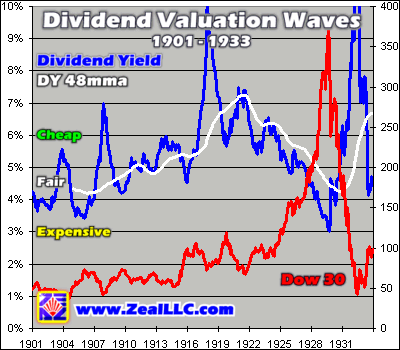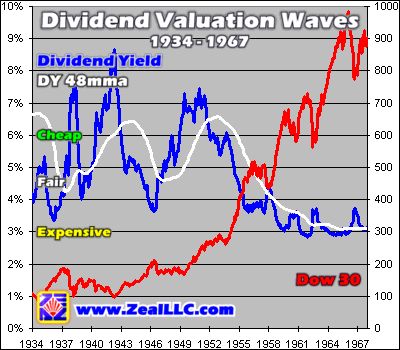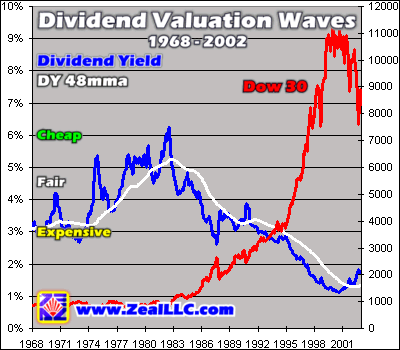|
|
|||||||
|
|
|
|
|
|
|
|
|
|
Dividend Valuation Waves Adam Hamilton January 10, 2003 3499 Words
Woohoo! Our imperial President has dragged himself away from the dangerous game of waging endless foreign wars long enough to throw hardworking Americans a token sop in the form of a small tax cut. Will wonders never cease?
I was earnestly hoping to hear about the disbanding of the unconstitutional Internal Revenue “Service” and the implementation of a simple, honest, and fair flat tax for all Americans, but alas it was not to be. Once again I guess that about half of the fruits of our hard labors in 2003 will be stolen by Uncle Sam to subsidize the lazy and unproductive this year.
Nevertheless, Bush’s modest proposal was a baby step in the right direction. I hope it is only the first sortie in the long overdue war against the welfare-state liberals and their loathsome politicians who ride on the backs of and plunder the hardworking American people like despotic Afghan warlords.
The centerpiece of Bush’s tax proposal involves the abolition of an abomination known as the dividend tax. The liberal socialist thieves who have slithered into the Halls of Power in the United States like a plague of fiery serpents have long supported this immoral plunder. The dividend tax is particularly abhorrent because the exact same income stream is taxed twice. Only tyrants layer taxes on top of taxes.
Dividends are simply cash payments made to the owners of one type of business entity, the ubiquitous corporation. As corporations carry out their business in the free markets, they work hard to earn profits for their shareholders. Some of these profits are paid out to their legal owners in the form of dividends.
When a corporation earns profits, it must pay taxes on these profits. Today the greedy welfare-state politicians steal about a third of the profits a corporation earns in its honorable business. After the corporate-level profits have been taxed and plundered, a corporation can decide to make cash dividend payments to its owners.
If you are a shareholder of a corporation, and it pays you dividends that you rightfully own since you put up the capital to become an owner, the liberal socialists tax you again on the dividends you earned. Dividends are strangely subject to double taxation, which is grossly immoral and indefensible. The corporation pays about a third in taxes on its profits and then you as an owner pay another third or more of taxes on the remainder distributed to you in the form of dividends!
For example, imagine a small business set up as a corporation that earned $1,000,000 in profits in 2002. Each year the IRS thugs come to the door of the corporation with guns and badges and force it to pay about 35% in taxes to support the bloated Welfare State. This first plundering leaves only $650,000 for the owners of the corporation.
Then, imagine that all the corporation’s after-tax earnings are distributed to their rightful owners as dividends. The IRS Gestapo once again show up with guns and badges and force the owners to ante up even more onerous taxation plunder. They will have to pay another 35%+ in personal federal income taxes on this very same after-tax corporate income. This leaves only $422,500 in after-tax after-tax income for the owners of the corporation to support their families.
The corporate owners, thanks to the immoral dividend double taxation, were forced to pay $577,500 in taxes on their original $1,000,000 in profits. This is an effective tax rate of almost 58%! 58% taxation is appalling and unjustifiable and places a horrific burden on free enterprise.
It is truly amazing that there are any entrepreneurs left in America today when the federal government alone steals almost 2/3rd of corporate profits and then foolishly squanders the precious capital on perpetually growing government!
Bush’s proposed abolition of dividend double taxation is an important step in the right direction for the ridiculous US taxation regime. While only a small tax victory for Americans in the huge tax war between the productive and those malevolent parasites who merely steal for a living, it is a wonderful step in the right direction.
As I heard this news on Tuesday, I was amazed to see the reaction in the US financial markets. The usual-suspect talking heads on financial television were falling all over themselves chortling with glee over how the abolition of dividend double taxation would unleash a spectacular new bull market in US equities. One prominent gentleman even forecast a 40% (yes, forty!) rise in the US stock markets this year thanks to Bush’s modest tax proposal!
While taxation is nothing more than naked, brazen, legalized theft and eliminating the second dividend tax is certainly very important, the US financial markets are an entirely separate issue. Dividends are indeed a crucial fundamental valuation component of the US equity markets, but will the abolition of the abominable double dividend taxation suddenly render the ongoing Great Bear bust extinct?
Is a new bull market upon us because the second dividend tax may finally be facing its long overdue execution? Perhaps a quick overview of over a century of dividend data from the US equity markets will offer some clues to this vital question.
The dividend data shown in the graphs below is from an earlier essay I wrote on long-term stock-market valuation cycles called “Long Valuation Waves”. In the essay we explored how the US equity markets undulate through history in great overvalued and then undervalued waves. While dividend yields were mentioned in this research, they took a back seat to price-to-earnings ratios as our primary long-term valuation metric.
This week we will examine the Long Valuation Waves through the fascinating perspective of dividends alone. As in the “Long Valuation Waves” essay, the dividend yield data shown below is for the general US stock markets, S&P Composite data. This general dividend data is graphed with the venerable Dow 30 as a proxy for general US stock-market price levels over time.
It is really interesting to observe the interaction between stock prices and general stock dividend yields over a century. Since the foundational ideas behind these graphs and the valuation waves concept were discussed in much detail in the earlier essay, we are going to burn through them pretty quickly this week.
We’ll begin by briefly scanning a couple graphs with the entire dataset, monthly running from 1901 to the end of 2002.
Computing dividend yields for any publicly-traded company is very easy. All you have to know is the current stock price and the amount of annual cash dividends per share paid to shareholders. Then just divide the annual cash dividends by the stock price to calculate the dividend yield. If a stock is trading at $50 per share and pays out $1 per share in annual cash dividends, then it has a dividend yield of 2%.
As discussed in “Long Valuation Waves”, dividend yields in the last century averaged about 4.6% for the general US equity markets. In all the graphs in this essay 4.6% is marked as fair value. Unlike valuations based solely on earnings, like the venerable P/E ratio, there is an inverse relationship between general dividend yields and general stock-market over or undervaluation.
When stocks are cheap they have high dividend yields, they pay out a relatively high percentage of their share price each year to their owners in cash dividends. The cheap level is arbitrarily marked in these graphs at 6%. As you examine the graphs, carefully observe the white 48-month moving average (48mma) of the dividend yield as well as the blue raw dividend yield itself and you will note that stocks generally rally in future years after cheap dividend yields around 6% are witnessed.
Conversely, when stocks are expensive they have low dividend yields. Their share prices are bid up so high that their annual cash dividend payments to their owners become relatively small in comparison. In these graphs, we marked 3% as the arbitrary expensive level. Once again, as you digest the graphs below you will note that stocks usually enter secular bear markets or trade sideways for years after expensive dividend yields around 3% are witnessed.
The next graph makes it easier to see the effect these low and high dividend yields tend to have on future stock prices. The Dow 30 price data is displayed on a logarithmic scale so its percentage changes are constant across over a century of data.
The Dividend Valuation Waves endlessly undulating across the vast seas of time have much more apparent effects on general stock-price levels from this graph’s perspective. Note how each time the dividend yield 48mma rose towards the 6% cheap level, stocks rallied quite dramatically in the following years.
On the opposing troughs of the waves, when stocks became far too overvalued and dividend yields plunged towards the 3% expensive range, stocks generally fell in future years as secular bear markets stepped in to maul out the speculative excesses and restore healthy fair-value balance to the financial-market world.
Dividend yields are a crucial strategic general valuation indicator and extremely important for long-term investors to monitor!
It is also quite provocative to note the all-time dividend yield low that the general US equity markets slammed into during the spectacular 2000 stock mega-mania bubble. General dividend yields were squeezed down to an excruciating 1% in the mania bidding frenzy for bubble stocks, a dismal level so incredibly low that it may not even have a past precedent in a major world market in all of history. We’ll come back to this stunning observation a bit farther below.
Since it is difficult to discern any tactical detail on over a hundred years of data squeezed into a small graph like the one above, we split this data out into roughly thirds plotted on three more graphs below. Once again these periods of valuation history were discussed in much more depth in both “Long Valuation Waves” and “Century of the Dow” if you’d like more background information.
Before the 1990s the spectacular market events of the 1920s were widely considered to be the ultimate example of a classic speculative mania in equities. Of course the events we just lived through last decade dwarfed the 1920s mania, but the 1920s are still incredibly important to study and seek to understand. For our purposes this week, please note the undulating white dividend valuation wave marking strategic times to go long and strategic times to vacate the stock markets entirely.
It is really interesting to note that a prudent contrarian investor could have bought into the stock market in the early 1920s when dividend yields were way over 6% and just screaming a major buy signal on general equity undervaluation. For a long-term strategic investor high dividend yields are one of the ultimate entry signals to go long stocks in general.
This same investor could have sold near the very top in 1929 when dividend yields plunged to 3% signaling that US equities were far too expensive. Low dividend yields are a fantastic exit signal for long-term investors to heed so their capital doesn’t get trapped and destroyed at the top of a major mania.
Dividends represent crucial core fundamental valuation data for the stock markets. High general dividend yields signal cheap general stocks and are almost always a perfect time to go long for a major secular bull market. Conversely, low general dividend yields signal expensive general stocks and are almost always an ideal time to liquidate long positions and buy cash or gold to prepare to weather a coming brutal secular bear market in future years.
Long-term investors only ignore general dividend yields at their own great peril!
The next third of the 20th century sends the same message loud and clear. While market history never repeats exactly, the degree to which it rhymes with the past is uncanny and often very impressive.
Once again the Dividend Valuation Waves gradually meandered through market time like a great river. Through much of the late 1930s and 1940s, high dividend yields signaled that US stocks were generally undervalued and it was a fabulous time for a strategic long-term contrarian investor to buy stocks. Anyone who bought in on the high dividend yields was perfectly situated to ride the magnificent bull market of the 1960s.
Conversely, by the time the Dow was approaching 1000 for its first time ever in 1966, dividend yields were languishing around 3% signaling that US stock prices had run up too far too fast. Low dividend yields signal the end of a secular bull and the imminent birth of a secular bear, the time to sell all general long stock positions and instead redeploy capital into cash, gold, maybe bonds, or some other non-stock assets.
Investors who sold stocks at dividend yields around 3% in the late 1960s were very thankful they did as they missed the terrible bear market in US equities in the early 1970s. They were also blessed with the awesome opportunity to invest in other Great Bulls such as gold and commodities in the late 1970s rather than have their precious capital locked up in downward and sideways trending stocks for almost two decades. It took about 17 long years for the Dow to decisively break through 1000 after it first approached it in the late 1960s. Talk about long-term investing!
Once again the undeniable message of the raw data is that Dividend Valuation Waves are incredibly serious business and no long-term investor should ignore dividend yields. Buying on the expensive point of the Dividend Valuation Waves will lead to almost certain losses for those investors who foolishly haven’t taken the time to understand valuation.
Finally, a brief look at the Dividend Valuation Waves in our modern market era is in order.
I found this graph particularly stunning and illuminating. It is really interesting that since 1968 we have witnessed almost one perfect dividend valuation wavelength. Stocks languished during the early years of this period when dividend yields were low and didn’t begin soaring until after dividend yields had spiked up towards high levels signaling undervalued stock markets near the halfway point. Every long-term stock investor on Earth needs to digest and understand the implications of this graph!
In the late 1960s everyone was bullish and stock valuations were far too high. The bulls would pay dearly for their folly too, as they would have to wait 17 agonizing years to earn any profits at all and they totally missed out on one of the greatest bull markets in modern history in gold. The markets exact a heavy and often lethal price from those who foolishly try to play the game with no regard for carefully buying low and selling high!
While perma-bulls blissfully frolicked unaware of the imminent danger they were in during the late 1960s, dividend yields were too low signaling expensive stock levels. A prudent long-term contrarian equity investor could have recognized this signal and sold out of stocks to avoid the coming nearly multi-decade bear market. Dividend yields alone would have provided contrarians with all the correct guidance they needed to sell high in the midst of a frenzy when the rest of the equity world was blinded by vast greed.
Fast forward to the early 1980s. Stocks had traded sideways for 17 painful years and magazine covers widely declared that stocks were dead. The sexy thing to invest in was gold, commodities, real estate, and other tangibles because of their recent spectacular bull markets. Yet, the gold bull was already over and stocks were quietly laying the foundations for their greatest rally in history.
A prudent contrarian who understood Dividend Valuation Waves could have bought stocks in the early 1980s on high dividend yields that signaled unsustainable undervaluation in general equities. He or she would have then been long for most of the enormous 1980s and 1990s bull market. Dividend yields do matter and provide fantastic long-term buy signals when they get too high.
Around 1995 dividend yields were once again plunging to the expensive level, and they signaled that the bull market in US equities that ran for 13 years was probably nearing its end. Amazingly, probably due to Alan Greenspan’s unprecedented monetary inflation which spawned the greatest equity speculative mania in history, the stock markets rocketed even higher as the monetary floodgates burst open and crushed dividend yields to all-time lows by the end of the millennium. The future price the markets will pay for this unsustainable anomaly will be dreadful.
General US equity dividend yields around 1% are flabbergasting. They are just dismal and so trivial that it makes owning stocks for dividends all but useless today because the cash dividend streams are so meager. What does it all mean?
There are a couple of ways to interpret this stunning anomaly.
The Wall Street perma-bulls would simply argue that dividends don’t matter anymore and that low dividend yields are meaningless in this brave new era of endless bull markets they are desperately hoping for. Interestingly, these are the exact same folks who swindled investors in 1999 and 2000 by telling them that earnings and valuations didn’t matter then either. We all now know what a Big Lie that was! Wall Street also falsely claimed at the times that the late 1920s and mid-1960s were “New Eras” as well. They never learn.
The contrarians, on the other hand, would argue that market history repeats itself and valuations do matter. If Dividend Valuation Waves have always undulated through market history, then they will probably keep on meandering into the future. Periods of high stock valuations signaled by low dividends will be followed by nasty secular bear markets that eventually lead to low stock valuations signaled by high dividend yields.
Low dividend yields, especially the record-low levels seen above, strongly signal the time to sell general US equities, not to buy!
Just like the “Valuation Wave Reversion” of the general equity P/E ratios, general dividend yields too will also mean-revert as the Dividend Valuation Waves roll on. While there will certainly be sharp bear-market rallies in equities in our current Great Bear bust to continue to part the foolish and naïve from their capital, no true secular long-term bull market will be reborn from the ashes until US stocks fall far enough for dividend yields to once again soar well above the 6% cheap level.
Dear friends, please don’t let the perma-bulls fool you. The Great Bear bust in the US will not be over until general valuations for US stocks fall from overvalued to fair-valued and even down to undervalued levels in the future. We are still near the top of an enormous Long Valuation Wave, the time to sell and get the heck out of Dodge, not the bottom of one at this peculiar moment in history.
While Bush’s proposed abolition of the immoral double taxation on corporate dividends is a great thing and a small step forward, taxing dividends once does not solve the core fundamental overvaluation problem in US equities. Amazingly, even if some miracle happened and every corporation in America suddenly doubled its dividends, they would still only be languishing near 3% rendering stocks still incredibly expensive in light of all historical precedent.
Tax cuts, while nice, do not increase corporate earnings nor increase the ability of corporations to pay dividends. Overvaluation is the mighty demon that today’s perma-bulls are vainly battling, not socialist taxation issues that can be fixed with the mere stroke of a pen.
Stock prices will be relentlessly and mercilessly pummeled down by the Great Bear until they are historically low relative to both earnings and dividends. Low P/Es and high dividend yields will mark The Ultimate Bottom, quite unlike the staggeringly high P/Es and unfathomably low dividend yields we see today.
If you are a long-term stock investor and want to have real-time monthly updates on the current dividend yields of both the S&P 500 and Dow 30 so you have a better idea of when The Bottom is near and the greatest stock buying opportunity in three generations finally arrives, we do painstakingly compute and publish them every month in our acclaimed Zeal Intelligence newsletter.
If you subscribe to the electronic PDF version of our newsletter this week, we will even e-mail you a complimentary copy of the current January 2003 issue just published last week. In addition to our comprehensive market outlook for 2003, it contains a discussion of the general dividend yields and P/E ratios we expect to see when The Ultimate Bottom in US equities eventually arrives in the coming years.
Dividends are extremely important in equity valuation and their long-term strategic buy and sell signals should not be ignored. Bush’s liberation of dividends from double taxation is wonderful to see, but it does not solve the fundamental overvaluation problem plaguing the US equity markets. The Great Bear is not over and there remains a long, long way to fall yet before we reach The Bottom. Caveat Emptor!
Adam Hamilton, CPA January 10, 2003 Subscribe |
|||||||
|
|
|
|
|
|
|
|
|
|
|
|
|
|
|
|||

